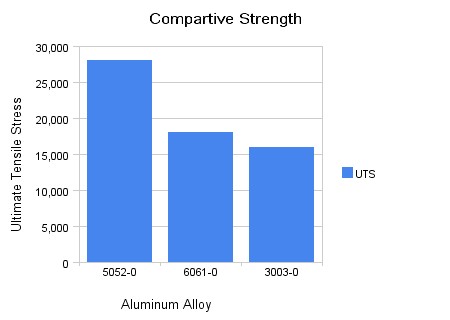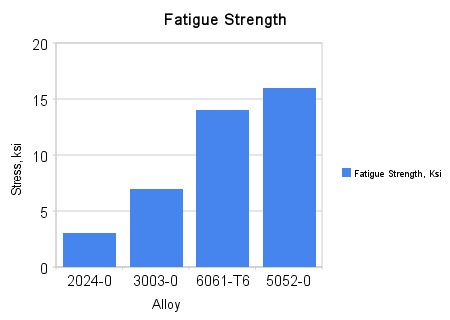Aluminium Tubing Strength for Mechanical
Most tubing failures on aircraft are caused by fatigue. You are warned that this chart does not compare fatigue strength. Tubing on aircraft vibrates. How well your tubing endures when subjected to load reversals, impulses, and vibration is called "fatigue strength". Of the three tubing types shown in the chart, 5052-0 has the best fatigue strength.
Originally aircraft used soft copper tubing. There is even some of this still around. Although copper was strong enough, it was replaced with aluminum and stainless steel because of the the high fatigue failures of copper. For lower pressure, 5052-0 became the tubing of choice because it has the best fatigue strength of any of the non heat-treat aluminum alloys. Copper tubing on older aircraft should be removed and replaced with 5052-0 before it breaks. There is no warning when copper tubing breaks. One cannot "inspect" it and declare it ok.
Some experimental and light-sport aircraft have hydraulic and fuel lines built with 6061-0 or 3003-0 tubing. Low ultimate tensile strength and low fatigue strength provide a narrow safety margin in dynmic (vibration or impulse) applications. Take extra care in clamping and preventing tube vibration. The aircraft industry's long experience with copper tubing failures proved the importance of fatigue strength. 5052-0 has higher ultimate tensile strength and higher fatigue strength at small price difference. Both 5052-0, 3003 have the same cold work ability Rating of A (easy to work with). 6061-T6 has a far lower rating of C.
The aluminum hydraulic lines on the Cessna 404 have experienced 5 reported failures due to metal fatigue. For the mechanic, this means that these lines cannot be inspected for fatigue failure. They will not show fatigue stress before failure. A replacement interval is the only method of prevening failure. The old adage that "if it flew in it will fly out" only works until the next failure. See NTSB Safety Board Recommendation A-83-1-2. Metal fluid lines in aircraft subject to vibration have a potential to fail due to metal fatigue. Using the proper alloy tube, combined with good fabrication techniques, and proper clamping, and hard-time replacement interval is the only protection from sudden failure due to metal fatigue.

Comparing ultimate tensile strength of three common aluminum tubing alloys used on small aircraft: 5052-0, 6061-0, and 3003-0

|
